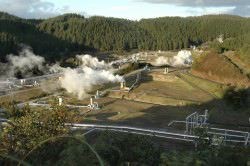A Calgary-based company is making progress on establishing a geothermal power plant south of Valemount.
If all works out, a plant capable of generating 10 megawatts of power and delivering a consistent flow of warm water for other possible uses - from greenhouses to tropical fish nurseries - will be up and running in the Canoe Reach-Kinbasket Lake region by no later than 2017.
But there is plenty of work between now and then, Borealis GeoPower chief geologist Craig Dunn said Friday, largely because such projects are so complex. Geothermal relies on heat from the Earth's core to boil water to the point where it can turn a turbine to generate electricity.
"It's not for the faint of heart," Dunn said. "I think that's one of the reasons the geothermal industry has struggled - there are so many aspects of a project.
"It's not like a wind project where you know what your resource looks like before you build a turbine. We have to actually spend money to verify our heat resource."
The B.C. energy ministry granted Borealis a geothermal exploration permit in October 2010 and the company is hoping to reach signed agreements with the Shuswap, the Skwlax, and the Simpcw First Nations by the end of this month.
The next steps, Dunn said, are to continue with exploration of its permit area to get a better understanding of the subsurface rock formations and then move forward with an exploratory drilling program "to map the heat, so to speak."
The company will also need to raise between $50 million and $100 million. It's a lot of money, Dunn agreed, "but then I come from an oil and gas background and there a $50 million project is something you don't bat an eye on."
The energy would either be sold to BC Hydro under a call for power from projects producing under 10 megawatts or to another power utility, such as Columbia Power, which develops power projects in the Columbia basin.
Once in place, the plant should provide a consistent source of power for a very long time.
"We've got about six billion years of heat," Dunn said. "The joke is the sun will burn out before the planet cools off."
The key is to properly maintain the plant and to pull out the right amount of heat - not so much that the reservoir gets tapped out but enough to keep the electricity flowing.
"It's something like an inventory in a grocery store," Dunn said. "If you don't stock it up fast enough, you'll run out but at other times you may have more than enough heat in the store if you're taking only one item out a day.
"Why that 10 megawatt value is so crucial is that we're actually pulling out less heat than the reservoir can provide."
Less than a dozen people would be employed at the site once in place about 15 kilometres south of Valemount, but Dunn said the real bonus for the surrounding area is the byproduct - warm water.
"If we have a 150 C resource, we can produce power and we may throw the water out, so to speak, at 70 C," Dunn said. "There's no reason water at 70 C doesn't have value."
The idea is to sell that water to users at a discount rate compared to water warmed by sources like natural gas and electricity.
"If people know they can get half-priced heat then you'll all sorts of business development, everything from greenhouses to, you know, you could grow tropical fruit," Dunn said, who added a community in Oregon is home to the world's largest inland tropical fish distribution centre.
Village of Valemount economic development officer Silvio Gislimberti said the municipality is applying for funding to pay for a study on possible options.



